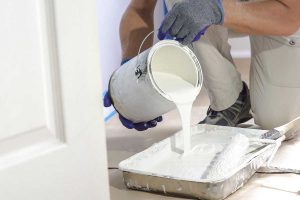Have you ever discovered an old can of paint in your basement or garage and wondered if it’s still good to use? At Soho Painters, we frequently get questions about paint longevity from our clients in New York City. Understanding paint shelf life is crucial whether you’re a homeowner with leftover paint from a previous project or a property manager maintaining supplies for touch-ups.
Paint doesn’t last forever. Different types have varying lifespans, and several factors affect how long paint remains usable, from storage conditions to whether the can has been opened. Using expired paint can lead to disappointing results: uneven coverage, improper adhesion, and even mold or mildew growth.
In this comprehensive guide, we’ll explore how long different types of paint last, both in the can and on your walls. We’ll also share professional tips on extending paint life and recognizing when it’s time to dispose of old products. By the end, you’ll have all the information you need to manage your paint inventory effectively and ensure beautiful, lasting results for your painting projects.
Shelf Life of Unopened Paint
The shelf life of unopened paint varies significantly based on the type of paint. When stored properly, here’s how long you can expect different paint formulations to last before opening:
Water-Based (Latex) Paint
Water-based paints, including latex and acrylic formulations, typically last 2-10 years when unopened. Premium-quality latex paints tend to have a longer shelf life than budget options. The paint’s components can separate over time, but this doesn’t necessarily mean the paint has gone bad. Often, a thorough mixing can revitalize separated latex paint.
We’ve found that temperature extremes are particularly damaging to water-based paints. Freezing temperatures can permanently damage the paint’s emulsion, causing streaks when painting walls. Similarly, excessive heat can cause the water in the paint to evaporate, even in sealed containers, resulting in thickened paint that’s difficult to work with.
Oil-Based Paint
Oil-based paints generally have a longer shelf life than water-based alternatives, often remaining usable for 10-15 years when stored properly. The oil and pigments in these paints are less susceptible to bacterial growth, contributing to their extended lifespan.
However, oil-based paints are still vulnerable to temperature fluctuations. Extreme cold can cause the oils to solidify, while high temperatures can accelerate oxidation, causing the paint to thicken. If you’re wondering whether primer is necessary before painting, the age of your paint may influence this decision.
Specialty Paints
Specialty paints like chalk paint, milk paint, and metallic finishes typically have shorter shelf lives, ranging from 1-5 years unopened. These paints often contain unique ingredients that may deteriorate faster than conventional formulations.
Signs Unopened Paint Has Gone Bad
Even if you’re within the expected shelf life, it’s important to check if unopened paint is still good before starting your project. Here are telltale signs that unopened paint should be discarded:
- Bulging or severely dented cans (indicating potential pressure build-up or contamination)
- Rusted cans with compromised seals
- Dried paint around the lid seal
- Strong rancid or sour odor upon opening
Lifespan of Opened Paint
Once you’ve cracked the seal on a paint can, the clock starts ticking at a faster pace. Exposure to air introduces bacteria and accelerates oxidation, shortening the paint’s usable life considerably.
Water-Based (Latex) Paint
After opening, most water-based paints last approximately 1-2 years if properly sealed and stored. When properly preserved, some premium quality paints might remain usable for up to 5 years.
The key to maximizing opened latex paint’s shelf life is creating an airtight seal. After use, clean the rim of the can thoroughly to ensure a tight seal when the lid is replaced. Some professionals place plastic wrap over the paint before sealing to create an additional barrier against air.
If you’re uncertain about using older latex paint, understanding when to prime before painting walls becomes especially important, as primer can help compensate for potential performance issues with older paint.
Oil-Based Paint
Opened oil-based paints typically last 1-3 years before becoming unusable. While they have preservatives that inhibit bacterial growth, they’re susceptible to oxidation once exposed to air.
A thin layer of oxidation (skin) may form on top of opened oil-based paint. In many cases, this can be carefully removed, and the paint underneath will still be usable. However, if the paint has thickened significantly throughout, it has likely gone bad.
Proper Storage Techniques
For all opened paint, proper storage is crucial:
- Store in a temperature-controlled environment (50-80°F)
- Keep away from direct sunlight
- Ensure lids are tightly sealed
- Store cans upside down to create a liquid seal around the lid
- Transfer small amounts to airtight containers to reduce air exposure
If you’ve left paint too long and are wondering if you can paint over semi-gloss with satin or other finish changes, the age of your base coat may affect your approach.
Durability of Applied Paint
Understanding how long paint lasts once applied to surfaces is equally important as knowing its shelf life in the can.
Interior Painted Surfaces
Interior paint typically lasts longer than exterior paint because it’s not exposed to harsh weather conditions. On average, you can expect:
- Living rooms and bedrooms: 7-10 years
- Kitchens and bathrooms: 3-5 years (due to moisture and cleaning)
- Ceilings: 10+ years
- Trim and molding: 5-7 years
- Hallways and high-traffic areas: 2-4 years
The quality of paint and preparation work significantly impacts longevity. Professional application with proper surface preparation can extend these timeframes considerably. Understanding how painting walls changes a room helps you appreciate the value of quality paint that lasts.
Exterior Painted Surfaces
Exterior paint faces much harsher conditions, reducing its lifespan:
- Wood siding: 3-7 years
- Aluminum siding: 5-10 years
- Stucco: 5-7 years
- Brick: 15-20 years (if previously painted)
- Trim: 2-5 years
Several factors influence exterior paint durability, including:
- Climate (UV exposure, rainfall, temperature fluctuations)
- Surface preparation quality
- Paint quality and type
- Number of coats applied
- Surface maintenance
For specialty surfaces, it’s worth knowing whether you can paint stainless steel or other unusual materials, as these applications may have different longevity expectations.
Extending Paint Lifespan
With proper techniques, you can maximize both the shelf life of your stored paint and the durability of applied finishes.
Storage Tips for Unused Paint
- Climate control: Store paint in a controlled environment between 50-80°F (10-27°C).
- Can maintenance: Wipe the rim of the can clean before replacing the lid to ensure a tight seal.
- Create a better seal: Place plastic wrap over the opening before putting the lid back on.
- Prevent air exposure: Transfer remaining paint to a smaller container if the can is less than one-third full.
- Label everything: Mark cans with the date opened, room/surface painted, and color information.
Reviving Older Paint
Before discarding paint that appears questionable, try these revival techniques:
For latex paint that has separated, stir thoroughly with a paint stirrer. If it blends back to a smooth consistency without lumps or graininess, it’s likely still usable.
For thickened latex paint, try adding water in small increments (no more than ½ cup per gallon) and mix thoroughly. If the paint returns to a smooth, even consistency, it may still be suitable for use.
Oil-based paints that have skinned over may be salvageable by carefully removing the skin and stirring the remaining paint. If the consistency remains smooth, it’s probably still good. Commercial paint reducers specific to oil-based paints can help restore proper consistency.
If you’re working with older paint, knowing what grit sandpaper to use before painting walls becomes essential for proper preparation.
Extending the Life of Applied Paint
To maximize the durability of painted surfaces:
- Proper preparation: Clean, sand, and prime surfaces properly before painting.
- Quality materials: Use high-quality paints and apply multiple coats.
- Maintenance: Clean painted surfaces regularly using appropriate cleaners.
- Address issues promptly: Fix moisture problems, cracks, or chips as soon as they appear.
- Protective clear coats: Consider applying clear protective finishes in high-traffic or moisture-prone areas.
For specialized surfaces, understanding if drywall needs mudding before painting can significantly impact how long your paint job will last.
When to Replace Paint
Despite your best efforts, paint eventually reaches the end of its useful life. Recognizing when paint has expired saves you from disappointing results and potential health hazards.
Signs Paint Has Expired
For latex paint:
- Lumpy or grainy texture that doesn’t smooth out with stirring
- Foul, rancid, or sour smell
- Mold growth on the surface
- Inability to mix into a homogeneous liquid
- Extreme separation that can’t be reincorporated
For oil-based paint:
- Thick, jelly-like consistency throughout
- Strong rancid oil smell
- Failure to blend into a smooth liquid after thorough stirring
- Persistent lumps or grainy texture
Safety Considerations
Using expired paint can pose several problems:
- Performance issues: Poor adhesion, uneven coverage, and premature peeling or cracking.
- Bacterial contamination: Especially in water-based paints, bacteria can grow over time and cause odors or even health issues when applied.
- VOC concerns: As paint breaks down, it may release higher levels of volatile organic compounds (VOCs). If you’re concerned about VOCs, our blog on VOC levels in paint provides helpful information.
Environmentally Responsible Disposal
Never pour paint down drains or throw full cans into regular trash. Instead:
- Use it up: For small amounts, consider using the paint for small projects or as primer for another job.
- Donate it: Many community organizations accept usable paint.
- Dry it out: For small amounts, remove the lid and let the paint dry completely before disposing of it in regular trash (check local regulations).
- Take to hazardous waste collection: Most communities have collection events or facilities for proper disposal of paint and other household hazardous waste.
Understanding how many times you can paint a wall can help you plan for eventual replacement and disposal needs.
Conclusion
Paint’s lifespan varies widely depending on type, storage conditions, and where it’s applied. By understanding these factors, you can make informed decisions about when to use stored paint and when to invest in fresh products for your painting projects.
For unopened cans, latex paint generally lasts 2-10 years, while oil-based paints can remain viable for 10-15 years. Once opened, expect a significant reduction in shelf life: 1-2 years for latex and 1-3 years for oil-based paints. Applied paint lasts between 3-10 years for interior surfaces and 3-20 years for exterior applications, depending on the specific surface and conditions.
When it’s time for your next painting project in New York City, Soho Painters is ready to provide expert guidance and professional services. Whether you need interior painting for a refreshed living space, exterior painting to enhance your property’s curb appeal, or specialized commercial painting services, our team uses only the highest quality paints with optimal shelf life and durability.
Ready to transform your space with fresh, properly stored paint that will stand the test of time? Contact us today for a consultation and free quote. Our experienced professionals will ensure your next painting project delivers beautiful, long-lasting results.





